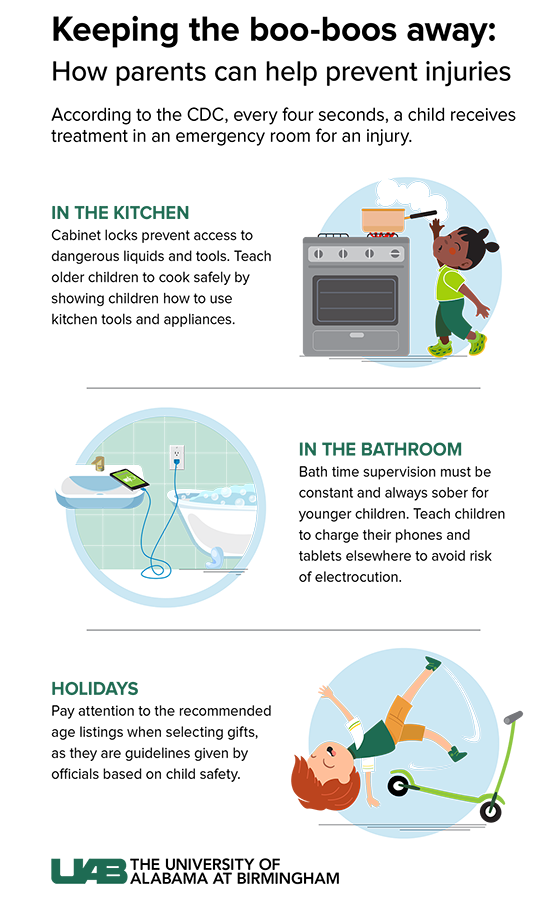 UAB experts highlight the social determinants of obesity and add to the growing body of evidence identifying potential solutions to address obesity and related conditions.
UAB experts highlight the social determinants of obesity and add to the growing body of evidence identifying potential solutions to address obesity and related conditions.
Click image to enlarge.
According to the Centers for Disease Control and Prevention, every four seconds, a child receives treatment in an emergency room for an injury. Every hour, a child dies from an injury. When it seems as though danger could be around every corner, how can parents keep their children as safe as possible — without the use of bubble wrap?
In his new book, “Raising Kids Who Choose Safety,” University of Alabama at Birmingham’s David Schwebel, Ph.D., associate vice president for Research Facilities and Infrastructure and director of the UAB Youth Safety Lab in the College of Arts and Sciences, introduces the teach, act, model and shape method, which describes simple steps parents can take to protect their children from injuries and guide them to make safe decisions as they grow older.
In the kitchen
Throughout his book, Schwebel explains how parents can address specific areas of safety concern in each domain of their life, and for each stage of their child’s life.
The kitchen can be a great safety concern for parents, as it contains a plethora of dangerous heated objects, chemicals, cleaning supplies, dangerous liquids and sharp tools. For toddlers, Schwebel suggests limiting access in this part of the house.
“Cabinet locks are an easy way to prevent young children from getting access to sharp knives, cleaning supplies and alcoholic beverages,” Schwebel said. “Even the most conscientious parents can get distracted, and it takes only seconds for a toddler to find a bottle of cleanser under the sink.”
If a child ingests any poison, call the Alabama Poison Information Center at Children's of Alabama at 1-800-222-1222.
As children grow older, Schwebel says, it is great to teach them to cook safely. Start by showing children how to use sharp knives, oven mitts and stovetops. Then, let them try while you supervise. Over time, children can learn to be safe in the kitchen.
In the bathroom
Before a child reaches the age of potty training, the bathroom will mostly be used for bath time. According to Schwebel, this is the biggest risk for infants.
Supervision is key. Something as small as sending a short text is enough of a distraction to turn bath time from an enjoyable occasion to one that involves an emergency room visit, due to drowning, hot bath water or electric shock.
“Bath time supervision must be constant and should always be sober,” Schwebel said. “Save the glass of wine for the end of the bedtime routine — an intoxicated parent can make intoxicated mistakes.”
 David Schwebel, Ph.D.
David Schwebel, Ph.D.
Photography: Lexi CoonAs children grow older, bathroom risks decrease, says Schwebel. But remember that electrical outlets and wet plugs create electrocution risks. Children should learn to charge their phones and tablets elsewhere to avoid risk.
Holidays
The holiday season is fast approaching, and some families are already making their preparations, which could include travel. Schwebel encourages parents to be aware that travel can bring disruptions to daily schedules, which can increase risks for injuries.
“Don’t let traveling relax your awareness of safety concerns; but instead, let it reinforce your enjoyment, and have fun with your children,” Schwebel said.
Some celebrated holidays include the tradition of exchanging gifts with loved ones. The Consumer Product Safety Commission estimated 198,000 toy-related injuries in 2020. Schwebel recommends paying attention to the recommended age listings when selecting gifts, as they are guidelines given by officials based on child safety.
“When your child receives gifts from friends or family, do a quick scan for product safety and determine whether your child is ready for this gift,” Schwebel said. “If you determine they are not age-appropriate, you can calmly say that you are putting it aside to play with later, and then store it until the child reaches the appropriate age.”
Safety concerns, tips and Schwebel’s TAMS method for child-accident prevention can be found in “Raising Kids Who Choose Safety,” which is now available online.